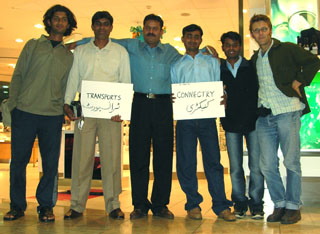'connectry'
In the streets of Karachi there is a fleet of exceptionally vibrant mini-buses plying their route. They are covered with decorative display, a dance of colour, lighting and reflection. Words on the side of one such mini-bus read in Urdu and English: ‘piyar zindagi hai / love is life’. These words can now be found on the side of one particular Melbourne tram. The name of this route is W-11. Take it as a starting point for travel.

In early 2006 Nusrat Iqbal and his team of ‘chamak patti’ vehicle decorators journeyed outside Pakistan for the first time to transform this tram as they would a Karachi mini-bus. Two cultures collided when Melbourne’s Preston tram workshop met North Karachi ‘chamak patti’ practice. ‘No tension!’ the Pakistani’s would banter. Respect and friendship emerged, and a gloriously hand elaborated tram opened its doors, revealing lettering on the entrance steps: ‘wel-come’.
Trams have not been seen in Karachi since the 1970s. Tramways were spawned throughout cities of the British Empire at the turn of the 19th century – including the major cities of the subcontinent and Australia – but were subject to a wave of worldwide closures during the 1960s and 70s. They now enjoy a worldwide return as part of encouraging sustainable urban living. Trams are a public transport with the potential to be moving places offering hospitality: spaces giving carriage to the many, accepting strangers, the unexpected, and the uninvited.
Camels, ox carts, river-boats and horses have long been personalised with decoration in many cultures, including that of the Indus valley. Vehicle decoration culture in Pakistan is related to domestic traditions of decorating what is valued – from shrines to brides, and even ghetto blasters. With the 1970s advent of city buses servicing flexible routes, a distinctive decorative style emerged of repousse stainless steel, hand-cut reflective plastic film and the poetry of personal philosophies. Owners of these W-11 route buses now spend an enormous amount of money and energy on decoration, motivated as much by rivalry with one another, as by the love of colour, splendour and display. And yet vehicle decoration has no economic benefit. A commonly held belief is that unless the source of one’s livelihood is properly honoured, it will not prosper.
In an increasingly homogenising and homogenised world, this practice of passionate decoration is a contemporary anomaly. The act of transporting this decoration practice from Karachi bus to Melbourne tram has opened up an alternative kind of journey. During the W-11 TRAM first season a participant commented that after twenty-five years of working on public transport he’d never seen people leaving with such a good feeling.
In Karachi today the front window of Iqbal’s 3x3 meter workshop marks the other-worldly connections of his work with a simple sign: W-11 Karachi 2 Melbourne. His North Karachi community of W-11 drivers, conductors and owners turned out in droves on a recent September night for an on-street video-screening showing their decorative world in its Melbournian manifestation. They roared, taken aback and elsewhere: affirmed and transported. They too joined a journey, along with those of us who’ve collaborated closely. We are now travelling together.
The W-11 TRAM carves out a dynamic social space colliding Melbourne and Karachi. Journeys are moved along by host artists, guest conversationalists, performers, as well as music that transports. A series of tickets share fragments of this vehicle’s imagery and unattributed poetry as seen on the side of the Karachi buses. What’s on offer is an experience of ‘connectry’. That’s the made-up word that emerged in the play of language between Karachi decorators and Melbourne artists. It describes something of what we experienced, witnessed and seemed to be enabling through this journey. ‘Connectry’ might be a form of spontaneous hospitality practiced by individuals toward others; simple and immediate ways that connect people in a side-by-side relation, moving and being moved.
Mick Douglas & Durriya Kazi



